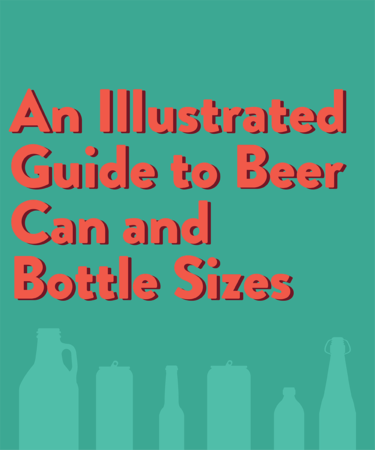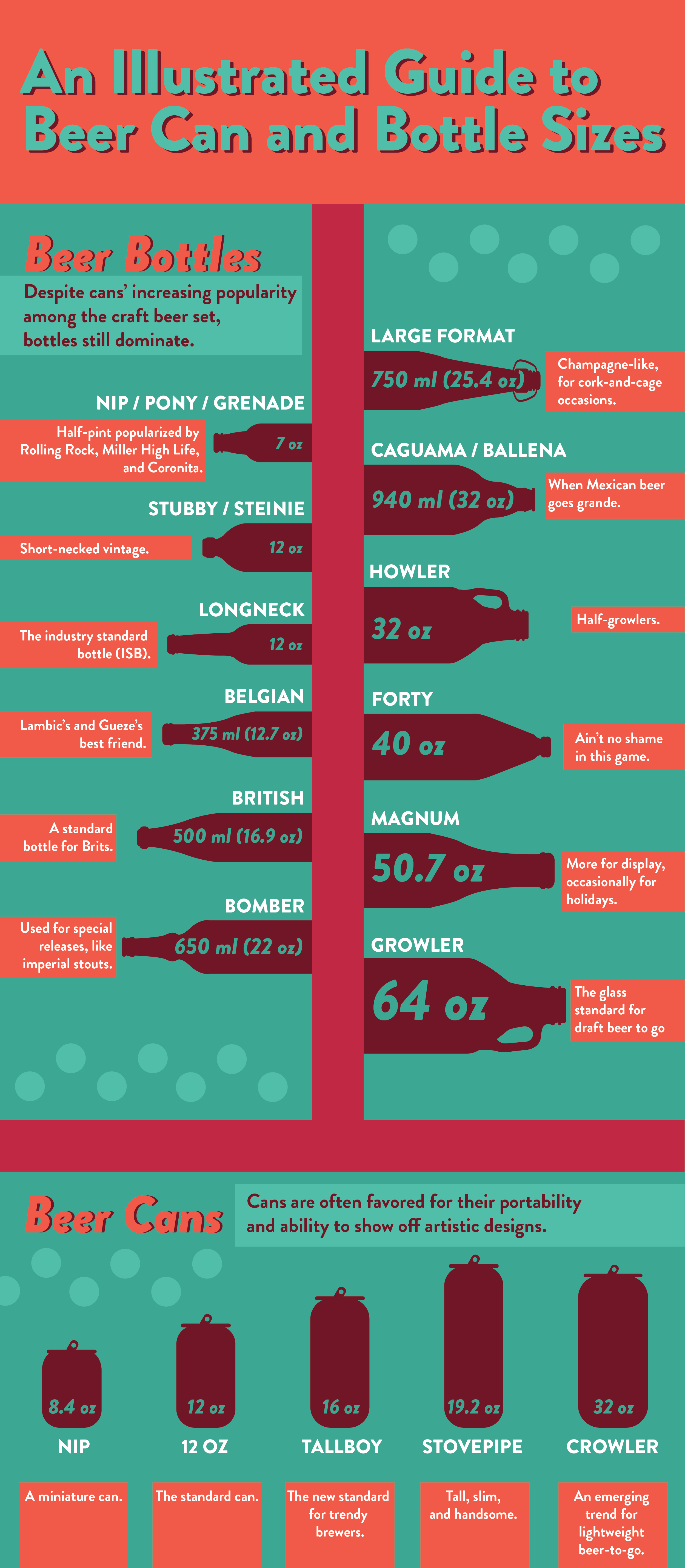
While large-format wine bottles get cool Biblical names like Jeroboam, Methuselah, and Balthazar, beer bottles and cans tend to have more approachable monikers. From tallboys to bombers to nips, beers of all sizes are, for the most part, easy enough to say aloud without risk of embarrassment.
What’s not always clear, however, is exactly what those sizes mean. That’s why we put together this handy infographic to clarify the colloquialisms of beer sizes. Now you won’t be confused the next time someone asks you to bring a “howler” to a bottle share. (No one calls it that, by the way.)
All The Types Of Beer Bottles & Cans
Beer Bottles
Despite cans’ increasing popularity among the craft beer set, bottles still dominate. Here is everything you need to know about the most popular sizes.
Nip / Pony / Grenade (7 oz)
The word “nip” harkens back to the 17th and 18th centuries, when “nipperkin” was abbreviated to “nip,” meaning a small measure of spirits, usually a half-pint or less. Popularized by brands like Rolling Rock, Miller High Life, and Coronita, you can still find this cute little vessel today, often served in a bucket of ice.
Stubby / Steinie (12 oz)
Short, stout, and, well, stubby, this bottle (also called a “steinie,” à la “beer stein”) is similar to a standard 12-oz bottle with a slightly smaller neck. Coors Banquet revived its 1936-vintage stubby bottle in 2013; Budweiser released a limited-edition amber lager, Budweiser 1933 Repeal Reserve, in 2017; and Miller Lite brought back its 1975 steinie in 2015.
Longneck (12 oz)
Also known as the Industry Standard Bottle (ISB) or North American longneck, this is the typical beer bottle size you find in any grocery store, often sold in 6-, 12-, and 24-packs.
Belgian (375 ml or 12.7 oz)
Though not necessarily limited to Belgian beer, this bottle size is typically the container of choice for lambic and gueuze-style beers. The size can vary, with many Belgian beers packaged in 330-ml (11.2-oz) bottles.
British (500 ml or 16.9 oz)
This is the standard beer bottle size in the U.K., though 330-ml and 275-ml bottles are also used there.
Bomber / Large Format (650 ml or 22 oz / 750 ml or 25.4 oz)
The 22-oz “bomber” and 750-ml large format bottle are often used by brewers for special limited-release beers and barrel-aged beers (imperial stouts, wild ales, etc.). Bombers are dressed up by being dipped in wax, while 750-ml large format bottles are corked and caged like Champagne.
Caguama / Ballena (940 ml or 32 oz)
Mexican beer brands like Tecate, Sol, and Pacifico can be found in caguama or ballena bottles.
Forty (40 oz)
Ain’t no shame in this game. This is where you’ll find malt liquor like Old English, as well as cheap lagers like Coors Light.
Howler (32 oz)
This is the term for half-growlers. (See growler below).
Magnum (50.7 oz)
Typically used as a display bottle rather than an actual sku, magnums are occasionally released by big beer brands like Heineken for special occasions and holidays.
Growler (64 oz)
Usually made of glass, this takeaway container is best for beer drunk fresh from the source. Learn about the history of the growler here.
Beer Cans
Favored for their portability and artistic designs, cans are in the midst of a modern renaissance. How many ounces are in a can of beer? Well, it depends — are we talking about a nip, crowler, or stovepipe? Read on to learn the different sizes of beer cans.
Nip (8.4 oz)
Akin to its glass cousin, the nip is a miniature version of a typical beer can.
12 oz
The standard can size popularized by macro lagers and adopted by craft brewers due to ease of transport and design capabilities. These are most often found in packs of 6, 12, 15, 18, 24, and 30.
Tallboy (16 oz)
Though 12-oz cans have long been the standard, the 16-oz pint can, also called a “tallboy,” is becoming trendy for many craft brewers. These are most often sold in 4-packs.
Stovepipe (19.2 oz)
This 19.2-oz can is relatively new but gaining popularity: According to market research firm IRI Worldwide, stovepipes experienced the largest growth of packaged sales from 2015 to 2017. Sierra Nevada recently released its BFD (“beer for drinking”) golden ale in this size.
Crowler (32 oz)
The convenient hybrid can-growler created by Oskar Blues is increasing in popularity across the U.S. Here’s more you should know about crowlers.

